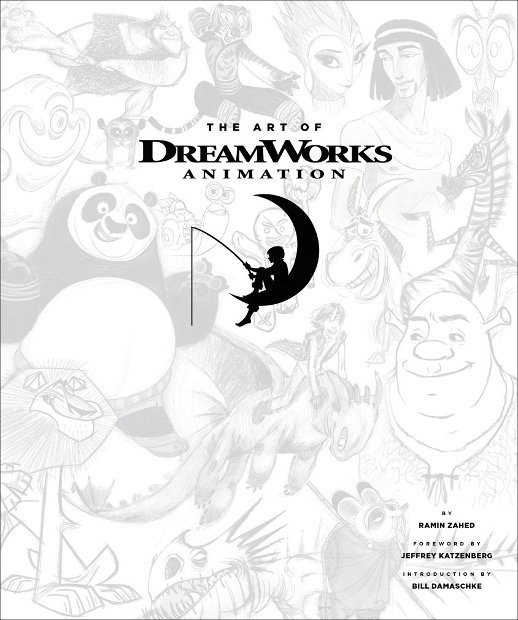Fred Patten reviews the fantastic new collection of concept and production art from every DreamWorks animated film.
NYC, Abrams, April 2014, hardcover $50.00 (323 [+ 1] pages).
This is not a traditional “art of” animation book. This large, full-color tome (10 X 12 inches), published to celebrate DreamWorks Animation’s twentieth anniversary, is a breathtakingly lovely catalogue of every animated film that DreamWorks has produced to date, and a few currently in production. There is some production art – a few model sheet sketches and storyboards – but over 90% of the more than 400 illustrations are finished concept art, looking as though they were created especially for this book. It is like a tour through the Louvre of modern cinematic animation.
Those who know the real story of the studio’s twenty years may want to quibble about some of the polished history said or implied here. The Prince of Egypt (1998), the second feature following Antz, is described as “DreamWorks Animation’s first feature.” (p. 22). Well, yes; DreamWorks SKG Studios was founded in October 1994, and for the first few years made primarily live-action features. (The spiritual forerunner of the animation was probably the comedy-fantasy MouseHunt, starring Nathan Lane and Lee Evans as bumbling brothers outsmarted by a small mouse.) Antz was the only animated feature produced under the name of the parent group. In 1997 the DreamWorks Animation subsidiary was created through the merger of DreamWorks’ animation units with Pacific Data Images, a company specializing in computer graphics animation; and The Prince of Egypt became its first feature. “… DreamWorks soon forayed into claymation with Chicken Run and Wallace & Gromit …” Not exactly. Dreamworks Animation was the American distributor of the English-made stop-motion features by Aardman Animations in Bristol. DreamWorks Animation (with PDI) did not become a legally separate company until 2004. But in general, this book is an accurate and complete presentation of every animated feature released by DreamWorks SKG and DreamWorks Animation from 1994 through 2014.
Antz. The Prince of Egypt. The Road to El Dorado. The silly comedy stop-motion of Chicken Run. The Western look of Spirit; Stallion of the Cimarron. Although the cinematic look of Spirit was pseudo-full cartoon animation, this section of The Art of DreamWorks Animation is all in the style of Western painters like Frederic Remington and Charles Russell. Each of DreamWorks Animation’s twenty-eight features, plus the two still to come later in 2014 (How to Train Your Dragon 2 and Home), are given eight to a dozen pages. There are the winners like Shrek and its sequels, and comparatively forgotten films like Shark Tale and Bee Movie. Some of the features emphasize a particular design style, and the pages on them artistically follow suit: the Mayan-Mesoamerican look of The Road to El Dorado; the classic Chinese look of the Kung Fu Panda duo; the European fairy-tale look of Far Far Away in the Shrek movies; the high-tech, futuristic superhero/villain look of Megamind; the gaudy, frenetic circus atmosphere of Madagascar 3.
Although this is primarily an art book, there are many informative snippets of text. “If you look closely at the chicken characters [in Chicken Run]. You’ll notice that they all wear something around their necks – scarves, pearls, collars. That was used to hide the seam between the clay and the plastic part of the models. I remember having a long discussion about the questions those scarves and pearls might bring. Would the audience be sitting there asking themselves, ‘why don’t the farmers ever question the fact that the chickens are wearing clothing?’ And of course, no one cared.” – Karey Kirkpatrick, Writer (p. 47).
The Art of Dreamworks Animation ends with a five page list of all the “Awards & Nominations” these features have won, and been nominated for. Academy Awards. AFI Awards. Annie Awards. Golden Globes. PGA Awards. VES Awards. Not just for Best Animated Feature, but for Voice Acting in an Animated Feature, Storyboarding in an Animated Feature, Animated Effects, Character Animation, and all the others. I believe in being complete, but after the third page, this begins to sound too self-congratulatory.
This is the sort of art book that makes you wonder what happens to the paintings after the feature is released and the book is published. Are they going into storage someplace? Almost every one ought to be hanging on a wall, in a home or an art museum. I would love to attend a post-production art auction of the originals – not that I could afford to buy any of them.
Ramin Zahed is the long-time editor of Animation Magazine and the author of a couple of “art of” coffee-table animation books. Bill Damaschke is DreamWorks Animation’s chief creative officer. Jeffrey Katzenberg should need no introduction.
--
Fred Patten has been a fan of animation since the first theatrical rerelease of Pinocchio (1945). He co-founded the first American fan club for Japanese anime in 1977, and was awarded the Comic-Con International's Inkpot Award in 1980 for introducing anime to American fandom. He began writing about anime for Animation World Magazine since its #5, August 1996. A major stroke in 2005 sidelined him for several years, but now he is back. He can be reached at fredpatten@earthlink.net.
















